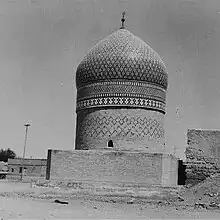Al-Kawaz Mosque
Al-Kawaz Mosque (Arabic: جامع الكواز) is a mosque in Basra, Iraq which was founded in 1514. It was built by a branch of Banu al-Abbas and is one of the only remaining Islamic-style minarets in Basra, with the other being al-Sarraji Mosque.[1][2][3]
| Al-Kawaz Mosque | |
|---|---|
Arabic: جامع الكواز | |
 | |
| Religion | |
| Affiliation | Islam |
| Ecclesiastical or organisational status | Mosque |
| Status | Active |
| Location | |
| Location | Basra, Iraq |
| Architecture | |
| Style | Iraqi Architecture |
| Founder | Sheikh Sari al-Abbasi |
| Completed | 1514 |
| Specifications | |
| Dome(s) | 1 |
| Minaret(s) | 1 |
| Minaret height | 25 metres (82 ft) |
| Site area | 1,000 square metres (11,000 sq ft) |
History
The mosque was founded in 1514 and built by Sheikh Sari al-Abbasi in three days. It was originally built from reeds, but was later built with stones in 1523.[1] At first, the mosque was simple in structure and was built with reeds and mud before it got built with stone by his son, Abd al-Qadir. It was where Sheikh Muhammad Amin al-Kawaz, the mystic Sheikh of the Shadhili order, used to teach the Qu'ran and religious sciences. When al-Kawaz passed away in 1546, he was buried in the mosque.[4]

In 1602, a descendent of Sheikh Sari, Sheikh Abd al-Salam II al-Abbasi, built the current dome of the mosque and a minaret. The mosque is in the sledge and is considered one of the rare minarets built in Islamic architecture and design at that time in Basra.[1] The dome, which still stands today, was erected on top of the tomb of Sheikh al-Kawaz and was decorated in multi-colored Faience which was very popular with architecture at the time.[4] In the 18th century, the minaret of al-Kawaz Mosque was the highest point in all of Basra.[5] The mosque contains two tombs. One is the tomb of one of the sons of Musa al-Kazim, and the other is the circular tomb of Sheikh Muhammad Amin al-Kawaz, the mystic Sufi leader of Shadhili order in Basra whom the mosque is named after.[5]
During the Gulf War, al-Kawaz Mosque was one of the many archaeological sites in Iraq that were affected by looting.[6]
Architecture
The mosque is made of bricks and includes a minaret and a dome which is built on a cylindrical body on top of the tomb of Sheikh al-Kawaz. The minaret of the mosque is located on a square base of stone. The base is about 5 meters tall with the cylindrical body of the minaret is built with bricks and stucco and is about 10 meters long. A basin is located on it which tops various muqarnas. The body of the minaret is decorated with various panels consisting of Kufic inscriptions and arranged in proportions by the wavy black brick border. The letters of the Kufic inscriptions, which includes the name "Allah", are written using glazed bricks in light blue livery.[4]
References
- "الأساس في أنساب بني العباس - أبجد". 2019-12-08. Archived from the original on 2019-12-08. Retrieved 2023-08-13.
- "بحجة غريبة.. هدم مئذنة عمرها 296 عاماً يشعل العراق". العربية (in Arabic). 2023-07-16. Retrieved 2023-08-13.
- السامرائي, يونس الشيخ إبراهيم (2005). تاريخ مساجد البصرة: الزبير-أبو الخصيب-الفاو (in Arabic). الدار العربية للموسوعات.
- فرنسيس, بشير يوسف. موسوعة المدن والمواقع في العراق - الجزء الأول (in Arabic). E-Kutub Ltd. ISBN 978-1-78058-262-7.
- Abdullah, Thabit (2001-01-01). Merchants, Mamluks, and Murder: The Political Economy of Trade in Eighteenth-Century Basra. SUNY Press. ISBN 978-0-7914-4808-3.
- "Non-compliance with Security Council's resolutions holds up UNESCO mission to reunite Iraq with treasures lost in Gulf War". The Art Newspaper - International art news and events. 1992-04-30. Retrieved 2023-08-13.
